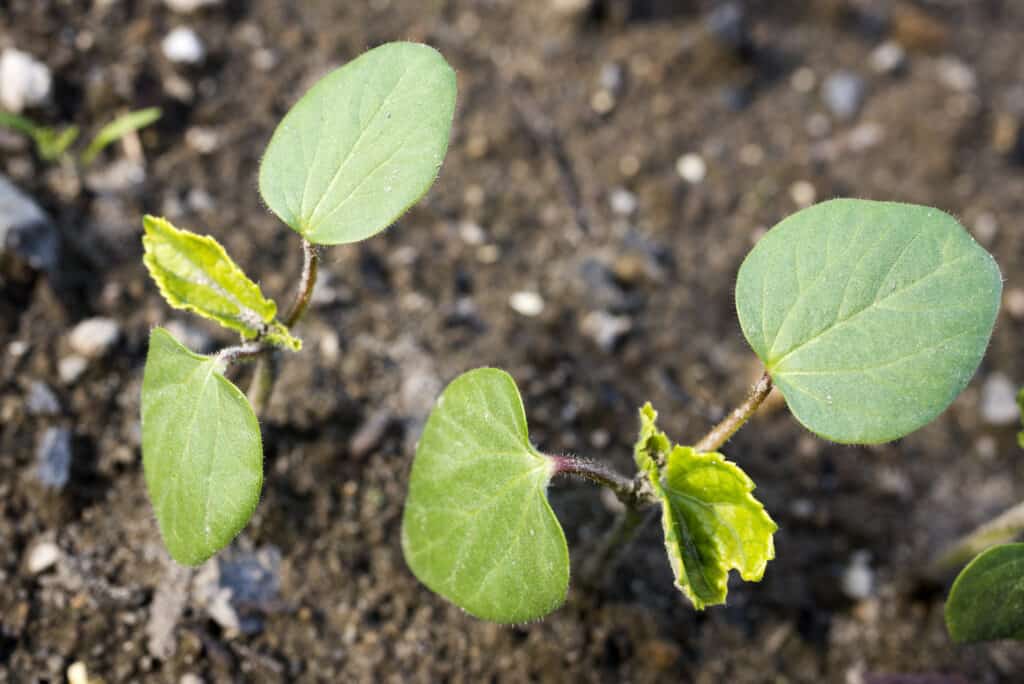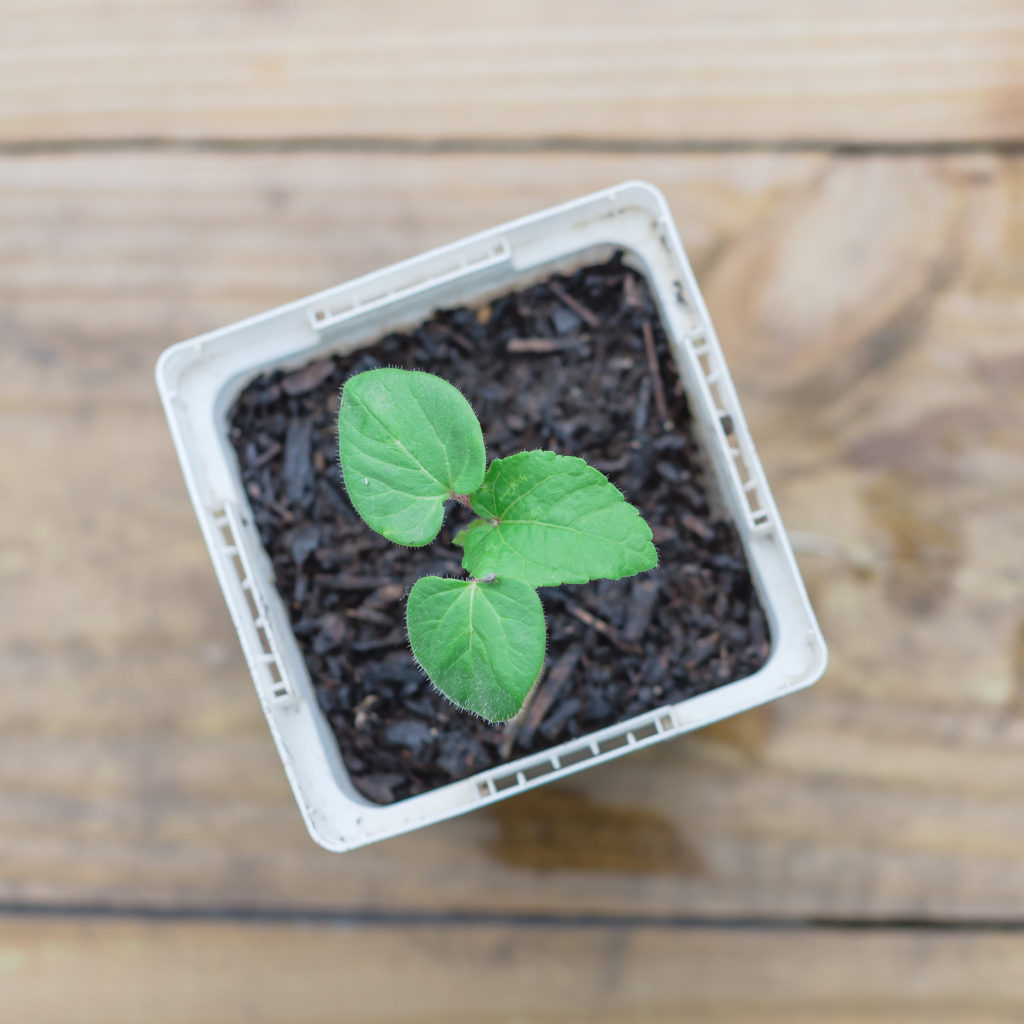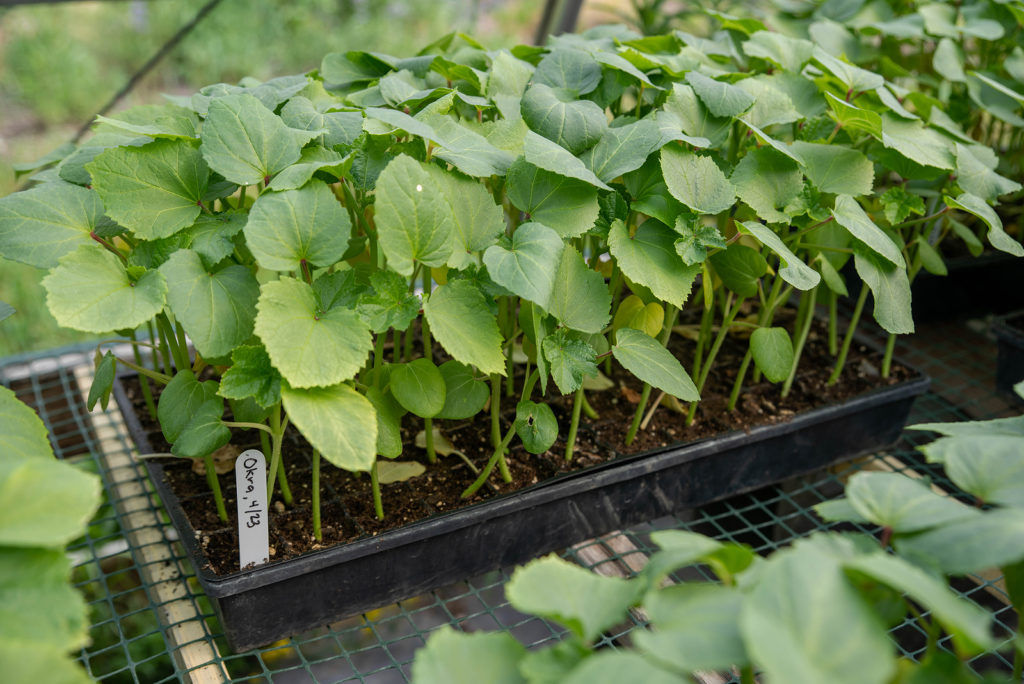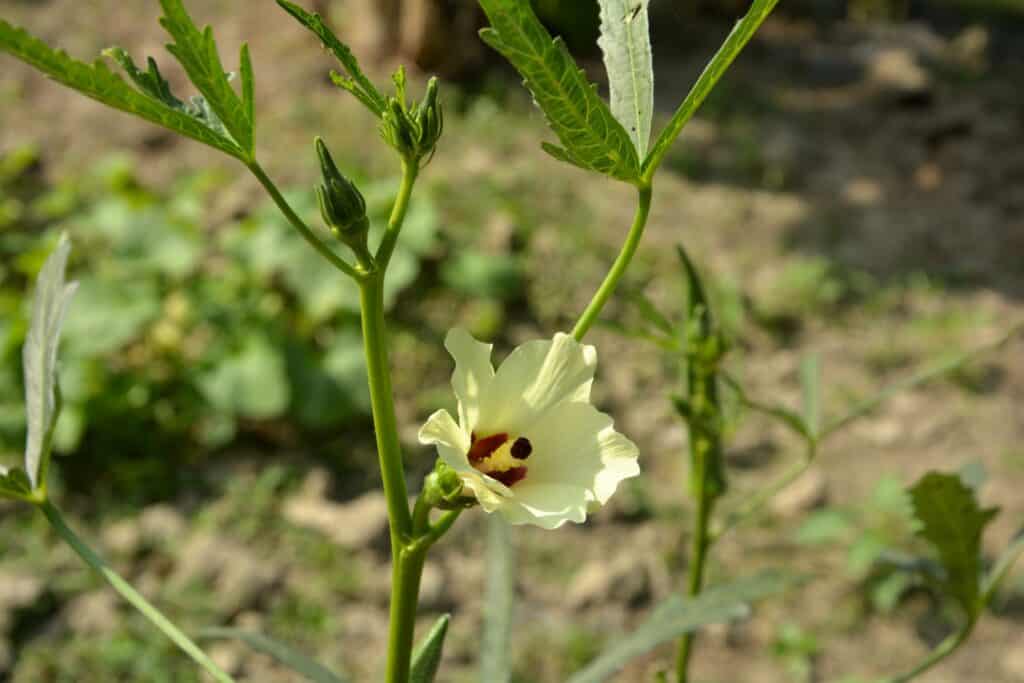Okra is a warm-season crop. Okra grows best when average temperatures are between 70° and 85°F (21-29°C).
Plant okra seedlings in the garden 3 to 4 weeks after the last frost in spring. Start okra seeds indoors 6 to 8 weeks before setting out plants. Direct sow okra in the garden after the last frost in spring when the soil has warmed to 60°F (16°C).

Okra is easily grown from seed. Okra is a tender, warm-weather annual that requires midsummer warmth and almost tropical heat for the best growth. Okra is native to northern Africa and is a favorite among southern gardeners in the United States.
Plant okra directly in the garden a few weeks after all danger of frost has passed in spring. For uninterrupted growth, okra wants a soil temperature of about 75°F (24°C). Planting in cooler soil will slow but not totally compromise okra root growth.
Good Products for Growing Tomato Family Crops:
- Espoma Garden Tone 3-4-4 Fertilizer
- Epsom Salt Plus Plant Nutrients Magriculture
- Tomato Grower’s Answer Book
- Neem Bliss 100-% Cold Pressed Neem Oil
- Safer Brand Insect Killing Soap
- Monterey BT Caterpillar Killer
- Southern Ag Liquid Copper Fungicide
- Harris Diatomaceous Earth with Duster
- Natures Good Guys Beneficial Nematodes
Okra seed can be started indoors about four weeks before the last frost. Wait until warm late spring or early summer temperatures are established before transplanting okra into the garden.
Plant okra in full sun. Plant okra in humus-rich, well-drained soil. Turn the soil to a depth of 8 inches before planting and add lots of well-aged compost or well-rotted-manure. Okra planted after early peas will benefit from the nitrogen stored in the soil by the pea nodules.
Space okra 12 to 18 inches (30-45cm) apart. Dwarf varieties can be planted closer together.
Okra matures 55 to 65 days after planting.
Okra is a key ingredient of gumbo and jambalaya.
Here is your guide to starting okra from seed both indoors and outdoors.

Okra planting details
- Sowing depth: 1/2 inch (12mm) or slightly more
- Space between plant after thinning: 12-18 inches (30-45cm)
- Days to sprout: 7-12
- Days to harvest: 55-65
- Storage period: 7-10 refrigerated
- Seeds per 100-row feet: 2 ounces
- Yield per 100-row feet: 175 pounds
- Suggested varieties: Blondie, Clemson Spineless, Dwarf Green Long Pod, Emerald Green
Okra seed starting basics
- Common name: Okra, gumbo
- Botanical name: Abelmoschus esculentus (Hibiscus esculentus)
- Family: Malvaceae, the same family as mallow and cotton
- Life cycle: Annual
- Fruit type: Capsule
- Seed-sowing depth: ½ inch (1.3 cm)
- Seed starting tips: Scarify seed coat or soak seed for 12 hours in warm water prior to sowing
- Seed-starting soil temperature: 70° to 95°F (21-35°C)
- Indoor seed starting time: Start seed indoors in peat pots or other biodegradable containers 4 to 5 weeks before the last frost. Bottom heat speeds germination.
- Light requirements: Bright light, full sun
- Transplant time: After the danger of frost; do not disturb the roots when transplanting.
- Direct sowing time: Direct sow 2 or 3 weeks after the last frost; okra wants a long season of warm weather for best pod development.
- Spacing in the garden: 18 inches (46 cm) apart for small varieties; 36 inches (91 cm) apart for tall varieties.
- Seed germination: 3-12 days; okra seed germination rate is about 65 percent.
- Flowers: 5-petaled flowers, usually yellow with purple centers, borne in terminal racemes or singly from leaf axils; flowers look like hibiscus flowers
- Pollination: Self-pollinating, insect-pollinated
- Cross-pollination: Can cross-pollinate with other okra varieties; cage plants or bag flowers to prevent cross-pollination.
- Isolation distance: ½ mile (0.8 km)
- Days to maturity: 50-60
- Harvest time: Pick the long, green seed pods when they are 2 to 3 ½ inches long. Cut the pods rather than pull them off the plant. Collect pods every other day to keep the plants producing; if pods mature on the plant, edible pod production will slow to a stop.
- Seed saving: Let the seed pods stay on the plant until they become completely mature; brittle, brown, and up to a foot long. In late fall, gather the pods, break them open, and shell out the seeds like beans. Dry and store.
- Seed processing: Dry pods on the plants or harvest prior to frost and allow pods to continue to dry fully. Wear gloves and long sleeves to harvest pods.
- Seed vitality: 2-3 years; typical germination rate is 65 percent

Okra sowing and planting tips
- Grow okra from seeds or seedlings.
- Okra seeds are viable for 2 years.
- Okra is commonly started indoors in a greenhouse or warm, well-lit sunroom or kitchen.
- Sow okra in individual pots of light potting mix 6 to 4 weeks before you intend to set plants out.
- Do not set okra outdoors until the nighttime temperature is consistently greater than 60°F (15°C)—even then you may want to protect plants from temperatures below 65°F (18°C).
- Sow 3 to 4 seeds in a pot or across flats; then clip away the weaker seedlings once the strongest seedling is about 2 inches (5 cm) tall.
- Sow seed ½ inch (13 mm) deep.
- The optimum soil temperature for germinating seed is 85°F (29°C).
- Keep the seed starting mix just moist until the seeds germinate.
- Okra seed can be sown directly in the garden if the soil temperature is warm enough—and there are enough days in the season for plants to reach maturity. The optimal growing soil temperature is 85°F (29°C).
- Okra seed germination takes 7 to 12 days at 85°F (29°C) or warmer.
- Seedlings started indoors should be kept under a grow light or in a sunny window after germination. Keep the indoor nighttime temperature above 65°F (18°C).
- Water to keep the seed starting mix from drying.
- Fertilize with fish emulsion or a soluble complete fertilizer at half strength.
- Transfer seedlings to a larger container once they are 2 to 4 inches (5-10 cm) tall; be sure that seedlings have sufficient room for root growth. This process is called “potting up”; continue to pot up seedlings as they outgrow containers—until they are transplanted into the garden or a very large container.
- Transplant okra to the garden after seedlings are at least 4 to 6 inches (10-15 cm) tall.
- Set plants 24 inches (60 cm) apart in rows at least 24 inches apart.
- Add aged compost, aged manure, and organic matter to planting beds in advance of transplanting.
- Okra prefers a soil pH range of 6.0 to 6.8.
- Grow okra in full sun for the best yield.
- Fertilize with an organic fertilizer such as fish emulsion at half strength.
- Give okra an inch of water (6.5 gallons) each week; okra does not like consistently wet soil.
- Protect plants from cold weather under lightweight spun poly row covers supported by wire hoops. Cold nights will cause blossoms to drop producing bushy plants without pods.
- Common okra pest enemies include aphids which excrete a sticky substance called honeydew which attracts ants, corn earworms, and flea beetles.
- Common okra diseases include powdery mildew and fusarium wilt. Crop rotation is important to stem diseases that affect okra.
More tips at How to Plant, Grow, and Harvest Okra.
Interplanting: Plant okra with basil, cucumbers, eggplants, melons, and peppers.
Container Growing: Choose a 15-gallon container for growing okra.

Okra planting calendar
- 4-6 weeks before the last frost in spring: start seed indoors.
- Transplant seedlings to the garden when nighttime temperature is consistently greater than 65°F.
- Sow seed directly in the garden when the minimum soil temperature is 75°F.
Okra planting dates
(These dates are for the Northern Hemisphere)
| Average date of the last frost | Planting dates |
| Jan. 30 | Feb. 15-Apr. 1 |
| Feb. 8 | Feb. 15-Apr. 15 |
| Feb. 18 | Mar. 1-June 1 |
| Feb. 28 | Mar. 10-June 1 |
| Mar. 10 | Mar. 20-June 1 |
| Mar. 20 | Apr. 1-Jun3 1 |
| Mar. 30 | Apr. 10-June 15 |
| Apr. 10 | Apr. 20-June 15 |
| Apr. 20 | May 1-June 1 |
| Apr. 30 | May 10-June 1 |
| May 10 | May 20-June 10 |
| May 20 | June 1-20 |
| May 30 | |
| June 10 |
Okra harvest
Okra matures 50 to 60 days after planting. Pick pods when they are 2 to 3 inches (5-8cm) long. Pods left on the plant that grow longer will be more fibrous and less palatable. Use okra soon after harvest; it does not store well.
Picking green pods as soon as they are edible size will encourage continuous production. Mature pods left on the plant signal it to stop producing. Cut the pods from branches rather than tugging them to avoid disturbing the roots.
Okra recommended varieties
Grow okra from quality seeds. Get seeds from a seed company that offers disease-resistant varieties.
- ‘Blondie’ and ‘Clemson Spineless’ are top performers.
- ‘Cajun Delight’ is a short-season variety of okra for cool regions.
- ‘Baby Bubba’ is a dwarf okra variety for small spaces.
Botanical Name: Abelmoschus esculentus
Okra is a member of the Malvaceae or mallow family; other members of this family are cacao and cotton.
Related articles for growing okra:
Seven Ways to Cook and Serve Okra
Okra Growing Problems: Troubleshooting
Garden Planning Books at Amazon:
- Tomato Grower’s Answer Book
- Vegetable Garden Almanac & Planner
- Kitchen Garden Grower’s Guide Vegetable Encyclopedia
- Vegetable Garden Grower’s Guide



